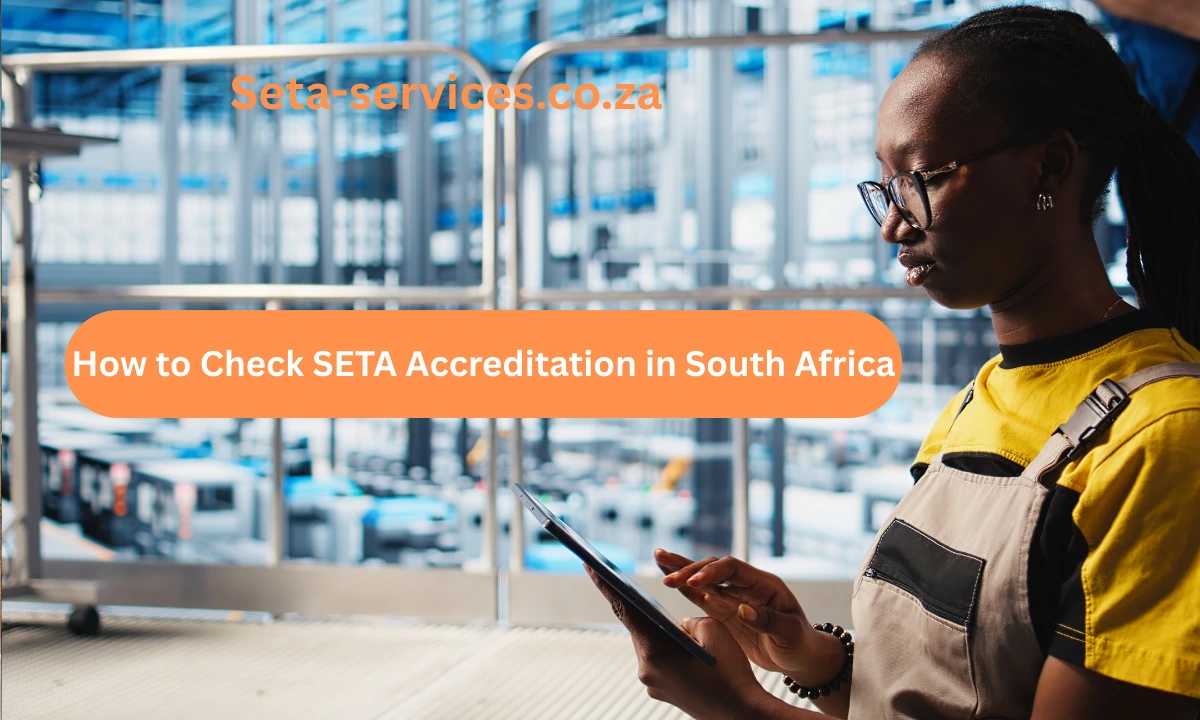How to Check SETA Accreditation in South Africa
Before enrolling in a learnership, training course, or skills programme in South Africa, verifying SETA accreditation is essential to ensure quality education and recognized qualifications. This 2025 guide explains what SETA accreditation is, why it matters, and provides practical steps to confirm a training provider’s status, protecting your time, money, and career prospects.
What Is SETA Accreditation?
Sector Education and Training Authorities (SETAs) are 21 government-established bodies under the Department of Higher Education and Training (DHET), each overseeing skills development in specific industries, such as IT (MICT SETA), construction (CETA), or agriculture (AgriSETA). SETA accreditation means a training provider has met rigorous quality standards set by the relevant SETA, ensuring:
- Alignment with the National Qualifications Framework (NQF) via the South African Qualifications Authority (SAQA).
- Outcome-based learning with practical, industry-relevant training.
- Nationally recognized certification upon completion.
- Delivery by qualified facilitators and assessors.
SETA-accredited programmes, including learnerships and skills courses, are designed to bridge skills gaps, with 70% of learners securing jobs within six months, per DHET 2024 data.
Why Is SETA Accreditation Important?
Verifying SETA accreditation safeguards you from fraudulent or low-quality training providers. Key benefits include:
- National Recognition
- SETA-accredited qualifications are registered with SAQA, ensuring credibility across South Africa.
- Example: A CATHSSETA-accredited tourism course is valued by hospitality employers nationwide.
- Eligibility for Learnerships and Bursaries
- Many SETA-funded learnerships (stipends of R5,000–R7,500/month), internships, and bursaries require enrollment with accredited providers.
- Employment Opportunities
- Employers prioritize candidates with accredited qualifications, enhancing your CV’s competitiveness.
- Example: A MerSETA-accredited welding certificate is highly sought in manufacturing.
How to Check If a Training Provider Is SETA Accredited
Follow these practical steps to verify SETA accreditation in 2025:
Step 1: Identify the Relevant SETA
Each SETA covers a specific industry. Match your training programme to the appropriate SETA:
- MICT SETA: Media, IT, and telecommunications (www.mict.org.za).
- Services SETA: Business, marketing, services (www.servicesseta.org.za).
- CETA: Construction (www.ceta.org.za).
- AgriSETA: Agriculture (www.agriseta.co.za).
- FASSET: Finance and accounting (www.fasset.org.za).
Find the full list of 21 SETAs on the National Skills Authority website (www.nationalskillsauthority.org.za) or SAQA (www.saqa.org.za).
Step 2: Visit the Official SETA Website
- Navigate to the relevant SETA’s website (e.g., www.mict.org.za for IT courses).
- Look for sections like “Accredited Providers,” “Registered Training Institutions,” or “Skills Development Providers.”
- Use search tools or downloadable PDF lists to find your provider’s name and accreditation status.
- Example: Services SETA offers a searchable database for accredited providers.
Step 3: Search on the SAQA Website
SAQA oversees all NQF-registered qualifications. To verify:
- Visit www.saqa.org.za.
- Go to “Qualifications and Part Qualifications” or “Registered Providers” sections.
- Search by provider name, qualification title, or accreditation number.
- Confirm the course’s NQF level (e.g., NQF Level 4) and the associated SETA.
- SAQA’s VeriSearch tool also allows verification of completed qualifications on the National Learners’ Records Database (NLRD).
Step 4: Contact the SETA Directly
If you can’t find the provider online or need clarification:
- Email: Check the SETA’s “Contact Us” page for dedicated addresses (e.g., EISArequests@serviceseta.org.za for Services SETA).
- Phone: Call the SETA’s head office (e.g., MICT SETA: +27 11 207 2600, AgriSETA: +27 12 301 5600).
- Visit: Some SETAs, like CETA in Midrand, offer in-person support at regional offices.
Most SETAs have teams to assist with accreditation queries, ensuring you get accurate information.
Red Flags to Watch Out For
Beware of providers that may not be SETA-accredited. Warning signs include:
- Promises of qualifications not listed on SAQA’s database.
- Lack of transparency (e.g., no accreditation number or contact details on their website).
- No mention of the relevant SETA or NQF level.
- Demands for full payment upfront without verifiable documentation.
- Vague claims like “pending accreditation” without evidence.
Pro Tip: Request the provider’s SETA accreditation certificate and cross-check it with the SETA or SAQA.
What Information Will You Need to Verify Accreditation?
To streamline verification, have the following details ready:
- Full name of the training institution (e.g., “PJB Learning Academy”).
- Accreditation number (if provided by the provider).
- Course or qualification name (e.g., “National Certificate: Plant Production”).
- NQF level of the course (e.g., NQF Level 1–4).
This information ensures precise searches and faster responses from SETAs or SAQA.
Bonus Tip: Confirm Certification After Completion
Upon completing a SETA-accredited course, you should receive:
- A Statement of Results (SoR) detailing your learning outcomes.
- A Certificate of Competency specifying the qualification, NQF level, and SETA.
Verify that the certificate:
- Lists the accredited institution’s name.
- Mentions the relevant SETA (e.g., “Accredited by AgriSETA”).
- Includes the course title and NQF level.
If these details are missing, contact the SETA or SAQA to confirm legitimacy.
Critical Note on Sources
The provided article aligns with web sources from SAQA (www.saqa.org.za) and Services SETA (www.servicesseta.org.za), confirming the process for checking accreditation via SETA websites and SAQA’s database. An X post from @Nayi_iplug (18 June 2024) mentions SETA-accredited learnerships but focuses on application details, not verification, so it’s not relied upon here. The article’s reference to 2024 is updated to 2025 for relevance, and all steps are consistent with current SETA processes. Candidates should always verify details directly via official channels to avoid outdated or fraudulent information.
Final Thoughts
Checking SETA accreditation is a critical step to ensure your training programme in South Africa is credible and leads to recognized qualifications. By identifying the relevant SETA, using official websites, and contacting authorities directly, you protect your investment and career prospects. In 2025, take control of your education—start by visiting www.saqa.org.za or your SETA’s website (e.g., www.ceta.org.za) to verify providers and secure your future.
Useful Resources
- SAQA: www.saqa.org.za – Verify qualifications and providers.
- National Skills Authority: www.nationalskillsauthority.org.za – List of all 21 SETAs.
- MICT SETA: www.mict.org.za – IT and media training providers.
- Services SETA: www.servicesseta.org.za – Business and services programmes.
- CETA: www.ceta.org.za – Construction learnerships.
- AgriSETA: www.agriseta.co.za – Agricultural training providers.
#SETAAccreditation2025
#SkillsDevelopment
#SouthAfricaEducation
#LearnershipVerification
#NQFQualifications
#SETACourses
#CareerTraining
#YouthEmployment
#SAQAVerification
#QualityEducation





